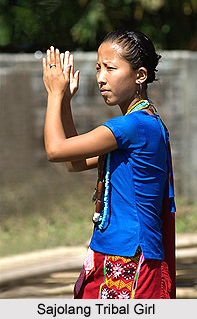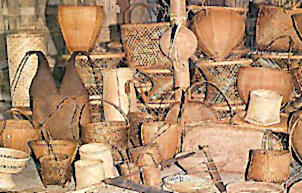 Culture of West Kameng District reflects a blend of customs and belief of the tribal people inhabiting in this district. Although a number of tribal groups constitute the total population pf the district, the density of the population is only eight per sq. kms. All the individual tribes have a rich cultural heritage and the state government of Arunachal Pradesh is making all efforts in helping conserve their traditional heritage. The society of the West Kameng district is patriarchal and primogeniture and the fundamental laws of inheritance with variations are not rare. They follow endogamy and strictly observe the rule of clan exogamy. Polygamy is socially sanctioned in this district. It is mostly practiced by most of them. Each tribe has its own organized institutions that maintain law and order, decide disputes and take up all activities for the welfare of the tribes and the villages. The people select the members constituting these organizations.
Culture of West Kameng District reflects a blend of customs and belief of the tribal people inhabiting in this district. Although a number of tribal groups constitute the total population pf the district, the density of the population is only eight per sq. kms. All the individual tribes have a rich cultural heritage and the state government of Arunachal Pradesh is making all efforts in helping conserve their traditional heritage. The society of the West Kameng district is patriarchal and primogeniture and the fundamental laws of inheritance with variations are not rare. They follow endogamy and strictly observe the rule of clan exogamy. Polygamy is socially sanctioned in this district. It is mostly practiced by most of them. Each tribe has its own organized institutions that maintain law and order, decide disputes and take up all activities for the welfare of the tribes and the villages. The people select the members constituting these organizations.
The major tribes of the West Kameng district are Aka tribes, Bugun tribe, Monpa tribe, Sajolang tribes and Sherdukpen tribes. The Aka tribes or Hrussos are the inhabitants of the Southeastern part of the district. The Aka tribal society is mainly based on two broad groups. They are Kutsun and Kevatsum. An Aka family is patriarchal and polygamy is practiced. Marriage takes place by the common way of negotiations or by elopements. Cross consul marriage is preferred to others. The Hrusso house is an elongated structure. The Hrussos has the prominent tattoo marks in the face. The Hrussos observe a number of ceremonies in the village. The most important community festival is known as Nechido, performed by village priest once in a year. The most common form of art is wood painting. The Hrussos are agriculturist and they practice shifting cultivation.
The Buguns inhabit in some of the village of Singchung administrative set up of the West Kameng district. The tribe is subdivided into a number of clans. Monogamy is the social norm but sometimes bigamy is also practiced. A Bugun family is patriarchal. The Buguns belong to the Mongoloid stock and are of fair complexion. The Bugun houses are like those of the Hrussos. The Buguns are agriculturist. They practice shifting cultivation and keep domesticated animals like cow, horse, pig, sheep, goat fowl, etc. The Buguns have a number of songs and dances that are mainly associated with their socio-religious festivals.
A Monpa family is patriarchal. Monpas tribe have castes and clans with no social hierarchy. A Monpa family is patriarchal. Monogamy generally rules though polygamy is also practiced. The Monpa belong to the Tibeto-Mongoloid stock and are the largest tribe of the district. Due to slight variations in dialects, Monpas can be divided into six linguistic groups, namely Tawang Monpa, Dirang Monpa, Lish Monpa, Boot Monpa, Kalaktang Monpa and Panchen Monpa. Each group has its own dialects. The Monpas are agriculturist. They practice both shifting and permanent types of cultivation. The Monpas are known for wood curving, painting religious scrolls, Carpet making and weaving.
 The Sajolangs live in the Valley of Bichom River and they are a small group of people. The Sajolangs put the prominent tattoo mark in faces. Basketry is a popular handicraft among the men folk. The Sajolangs are agriculturist and practices shifting cultivation. They also do hunting and fishing. The Sajolangs observe a number of ceremonies in the villages. The most important celebration is known as Fungglin or Chindang. The Sherdukpen belong to Tibeto-Mongoloid stock and they are fair in complexion. The Sherdukpen society is based on two classes. They are Thong and Chao. The two classes are again divided into several clans. A Sherdukpen family is patriarchal and they practice monogamous type of marriage. The Sherdukpen houses are generally erected on substantial stone foundations. The floor and walls are made of thick wooden planks.
The Sajolangs live in the Valley of Bichom River and they are a small group of people. The Sajolangs put the prominent tattoo mark in faces. Basketry is a popular handicraft among the men folk. The Sajolangs are agriculturist and practices shifting cultivation. They also do hunting and fishing. The Sajolangs observe a number of ceremonies in the villages. The most important celebration is known as Fungglin or Chindang. The Sherdukpen belong to Tibeto-Mongoloid stock and they are fair in complexion. The Sherdukpen society is based on two classes. They are Thong and Chao. The two classes are again divided into several clans. A Sherdukpen family is patriarchal and they practice monogamous type of marriage. The Sherdukpen houses are generally erected on substantial stone foundations. The floor and walls are made of thick wooden planks.
Thus, the entire population of the West Kameng district can be divided into two cultural groups based on their socio-politico-religious affinities. It has been found that the tribes of this district were integrated into groups independent of each other. The common denominators were that the patterns of lifestyle of each were the same and that they followed the same occupation. The tribal societies were casteless. Chiefs mostly governed these, the adults grouped according to their age for distinct social functions, and the young organized around dormitory institutions to act as the implementing instruments of the decisions and instructions of the older generation.
The people may be divided into two cultural groups on the basis of their socio - religious affinities. The Monpas and Sherdukpens of district follow the lamaistic tradition of Mahayana Buddhism . Noted for their religious fervour, the villages of these communities have richly decorated Buddhist temples, locally called `Gompas`. Though largely agriculturists, practicing terrace cultivation, many of these people are also pastoral and breed herds of yak and mountain sheep. The second group of the people includes Akas, Mijis and Buguns who worship Sun and Moon God namely, Donyi-Polo and Abo-Tani. Their religious rituals largely coincide with phases of agricultural cycles. They invoke nature deities and make animal sacrifices. They traditionally practice Jhoom cultivation or shifting cultivation. They also practice Buddhism. Hence, it can be said that the culture of West Kameng district is principally a reflection of indigenous tribal traditions and lifestyle.



















